The Right Way to Achieve Profitable Growth in the Chinese Consumer Market
The Chinese consumer market has awesome demographics. It is huge, young and growing. But competition in the consumer market is growing, too. To win in China, companies must create strategies that overcome pitfalls while taking advantage of local strengths.
The objective of this two-part series of articles is to identify the challenges that multinational companies face in China and describe what they should do to achieve profitable growth.
This first article highlights the common pitfalls encountered in China and discusses the expected changes in the Chinese market and competitive environment. Companies will find competing in the consumer market there to be very challenging. They will no longer be able to "wing" it ; rather, they will need to take a rigorous, integrated approach.
The second article, to be published in an upcoming issue of Strategy & Business, will describe what this integrated approach should entail. Companies should begin by generating deep consumer insights and building strong local capabilities. They should transform these insights into superior product market strategies, effectively manage sales and distribution and aim to achieve operational excellence. They also need to develop an organization that is flexible, open to learning and adaptive in order to cope with China's vast size, high diversity and rapid rate of change.
CHINA'S CONSUMER INDUSTRY:
A NEW BATTLEFIELD
China is one of the most discussed topics in the multinational business community. Because of the country's vast size and huge development potential, many multinational consumer product companies believe they must compete there. Yet the special characteristics of the Chinese market have made a presence challenging at best and often frustrating. China's size, diversity and rapid change, not to mention its culture and the broad influence of its Government, all contribute to a difficult operating environment.
On top of these factors, competition in many consumer product sectors is intense. Local players, leading multinationals and overseas Chinese companies are all vying for business from the country's huge pool of consumers. Companies are applying and testing various strategic and operating approaches in this rapidly evolving market. Indeed, China's consumer industry has become a dynamic business laboratory, one in which some multinational companies have found early success but even more have been losing significant amounts of money.
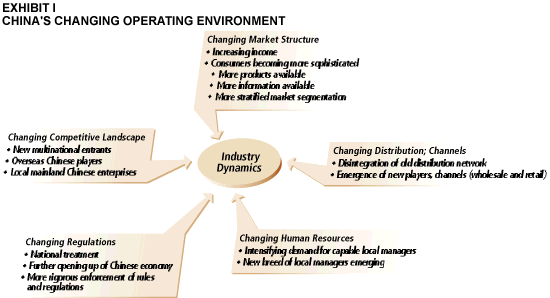
Despite the mixed results, most major multinational companies still regard China as an important opportunity that they do not want to give up. For many, market entry to China is now complete and they are currently deciding whether they can grow their business profitably beyond their first entry base. Making that leap, however, will be a major challenge. The factors involved -- consumer, market, product, competition, sales and distribution, retail, organization and human resources -- are all changing. They are too complicated to be dealt with individually, yet they are often interrelated so that they must be considered on an integrated basis. (See Exhibit I.)
One thing is clear: China's consumer market is strategically attractive to many multinationals. The country's demographics and long-term economics are overwhelming in terms of their potential. Chinese consumers are already migrating from basic products to more sophisticated, more expensive ones. Their decision-making can be influenced. Further, the consumer industry is, by and large, a level playing field for the participants, especially in the fast-moving consumer goods sector. Its regulatory environment is the most liberalized in China.
Combined, these factors have made China a major imperative for most big multinationals. Indeed, for some, such as Coca-Cola, Ericsson and Procter & Gamble, the country has become one of their largest markets in Asia, or even the world.
DEMOGRAPHICS AND ECONOMICS
China's demographics are awesome. Despite fluctuations, which sometimes are volatile, China's overall economy has been progressing impressively since it opened up in the late 1970's. This trend has been even more pronounced during the last decade. China's G.D.P. has been growing at about 9 to 10 percent a year for the last 15 years. Per-capita G.D.P. has reached about $660. Adjusted for purchasing power parity, China's G.D.P. is already one of the highest in the world.
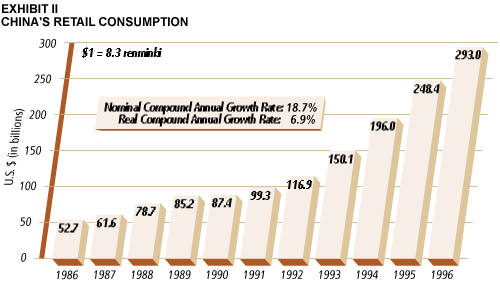
Two structural factors -- age and family -- add to the potential growth of the Chinese consumer market. China's population is predominantly young, with about 60 percent under the age of 35. With the continuing opening of China, these young people have been quick to adapt to new cultural values. In a Gallup survey in 1994, 68 percent of the respondents said that they would prefer to "work hard and get rich." At the same time, the country's one-child policy has reconstituted the structure and size of the family. The average Chinese family now tends to allocate more money for discretionary consumer products, especially for the single child.
Assuming no drastic change in the current economic and political trends in China, the country is expected to become a major consumer market by the early 2000's, at least for fast-moving consumer goods and perhaps even for "big ticket" durables.
ADVANCING CONSUMERS
Chinese consumers have been willing to spend their money on various products. The penetration of many consumer categories in Chinese households is already high. Basic "necessity" products such as bicycles, refrigerators, washing machines and television sets -- with color TV's substituting for black-and-white models -- are owned by more than 80 percent of the population in urban China. The penetration level seems to be on the rise even with more sophisticated and expensive durables, such as air-conditioners, mobile phones, personal computers and cameras. In less than two years, China has become the largest market for video compact disk players in the world.
This overall consumer pattern has taken shape despite the fact that many "internationally branded" products are being sold at "international prices." Furthermore, perhaps due to the lack of an installed base, product leapfrogging is very common in China, especially in major cities. Digital mobile phones have now captured a larger market share than their analog counterparts. Automatic washing machines are more common than non-automatic ones. Color televisions have dominated their market, and models that are 25 inches or larger are now the most popular.
Increasingly, Chinese consumers are being presented with more product and service information. Their purchasing decisions are also being influenced by promotions, other direct marketing approaches and, in particular, advertising. Television penetration in China is already high. By 1995, official statistics indicated that urban color television penetration had reached about 90 percent, while the rural black-and-white television penetration had broken the 60 percent level. Real advertising spending in China has been growing at around 60 percent a year since 1990. In a survey, more than half of the respondents said that television ads influenced their first-time purchase of the brand they used most often for a home-care product.
LEVELING THE PLAYING FIELD
In China, the mass consumer products industry is probably the most liberalized, making it a relatively level playing field for all participants. The liberalization manifests itself in product market flexibility, pricing, product channeling and service rendering, export and ownership.
Compared to other industries, relatively few Government restrictions have been applied to consumer goods for manufacturing, pricing and distribution. For most fast-moving consumer goods, companies have substantial freedom to decide what products to make and where to sell them.
Foreign investors can sell their own branded products, but some Sino-foreign joint ventures also sell locally branded products, typically inherited from the local partner. Pricing is generally unregulated. The distribution system has been deregulated to the extent that a wide range of options is available. State-owned distributors are no longer the only way to go; private entrepreneurs and other non-state distributors have emerged. Some foreign distributors have teamed up with local players to provide distribution services. In addition, direct distribution is permitted for products manufactured by foreign-invested subsidiaries.
The retail market is also liberalizing rapidly and new retail formats are emerging. The Government does not dictate the retail channels through which manufacturers must sell their products.
Unlike other more controlled sectors, the consumer goods industry also has few restrictions on the form of ownership for foreign companies. The equity share in joint ventures is not regulated. Companies are allowed to form wholly owned foreign enterprises. Some companies choose to form a "joint venture" with a local partner that contributes only a very small share of the equity. This allows the foreign company to have dominant control of the venture, making it virtually a wholly owned foreign enterprise.
INTENSIFYING COMPETITION
Chinese industries are traditionally supplied by dispersed manufacturers, often numbering in the hundreds. In China's planned economy, regions were designed to be mostly self-sufficient to minimize the burden of distribution and logistics and to enhance local employment. This gave rise to many locally "branded" products, among which Phoenix bicycles, Maxam toothpaste, Seagull shampoo, White Cat detergent and Tsingtao beer were traditionally very popular.
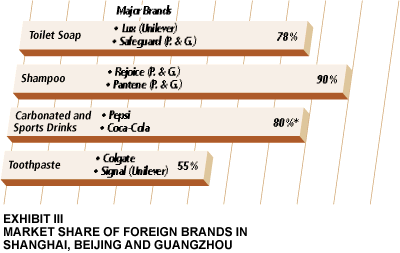
Attracted by the fundamentals of the China market, many multinationals entered the country in the last 10 years or so. The speed and scale of the entries intensified, in particular, after 1992, when Deng Xiaoping visited the southern city of Shenzhen to accelerate China's economic reforms. The arrival of the multinationals has been significant not only for fast-moving consumer products but also for many "big ticket" durable goods sectors. For example:
![]() In the household chemicals sector, multinational companies such as Procter & Gamble, S.C. Johnson, Henkel, Unilever and Kao have developed major presences in China. Procter & Gamble, one of the earliest entrants, has a dominant position in shampoo, soap and skin-care products. Henkel has several joint ventures across China manufacturing cosmetics, detergents and other products. S.C. Johnson has secured a strong position in insect control. Unilever's Shanghai joint venture makes soap and toothpaste. Kao has a manufacturing base in Shanghai making shampoo and detergent. The Asian Wall Street Journal reported that multinational companies dominate the shampoo, toothpaste, toilet soap and carbonated drinks markets in China's top three cities. (See Exhibit III.)
In the household chemicals sector, multinational companies such as Procter & Gamble, S.C. Johnson, Henkel, Unilever and Kao have developed major presences in China. Procter & Gamble, one of the earliest entrants, has a dominant position in shampoo, soap and skin-care products. Henkel has several joint ventures across China manufacturing cosmetics, detergents and other products. S.C. Johnson has secured a strong position in insect control. Unilever's Shanghai joint venture makes soap and toothpaste. Kao has a manufacturing base in Shanghai making shampoo and detergent. The Asian Wall Street Journal reported that multinational companies dominate the shampoo, toothpaste, toilet soap and carbonated drinks markets in China's top three cities. (See Exhibit III.)
![]() Coca-Cola and Pepsico dominate the carbonated drink sector. Both companies have invested hundreds of millions of dollars in China and are committed to increased investments.
Coca-Cola and Pepsico dominate the carbonated drink sector. Both companies have invested hundreds of millions of dollars in China and are committed to increased investments.
![]() In the beer industry, perhaps the most crowded one in China, more than 20 of the world's largest international beer companies have entered the country since 1989. They have joined a large number of domestic beer makers in a highly fragmented market where the largest share is no more than 5 percent.
In the beer industry, perhaps the most crowded one in China, more than 20 of the world's largest international beer companies have entered the country since 1989. They have joined a large number of domestic beer makers in a highly fragmented market where the largest share is no more than 5 percent.
![]() In the white-goods sector, most of the world's leaders are operating in China. In the early 1980's, many of these companies set up technology- transfer arrangements with select Chinese suppliers. Since 1990, however, they have often established joint ventures or wholly owned entities. In fact, during the second half of 1994, when the rush to invest in China was at a feverish level, top players flooded into China. Companies such as Whirlpool, Ariston, Electrolux, Bosch-Siemens, Hitachi, Sharp and Matsushita have invested hundreds of millions of dollars.
In the white-goods sector, most of the world's leaders are operating in China. In the early 1980's, many of these companies set up technology- transfer arrangements with select Chinese suppliers. Since 1990, however, they have often established joint ventures or wholly owned entities. In fact, during the second half of 1994, when the rush to invest in China was at a feverish level, top players flooded into China. Companies such as Whirlpool, Ariston, Electrolux, Bosch-Siemens, Hitachi, Sharp and Matsushita have invested hundreds of millions of dollars.
![]() In the quickly expanding personal computer industry, AST, I.B.M., Compaq, Hewlett-Packard, Digital, NEC and Dell are juggling for market dominance in what is a very fragmented sector.
In the quickly expanding personal computer industry, AST, I.B.M., Compaq, Hewlett-Packard, Digital, NEC and Dell are juggling for market dominance in what is a very fragmented sector.
![]() In the mobile telephone sector, Motorola enjoyed early success as a first mover into China, but Nokia and Ericsson are quickly capturing business with a consumer marketing approach. While these three companies dominate the sector, at least a dozen other multinationals have also entered.
In the mobile telephone sector, Motorola enjoyed early success as a first mover into China, but Nokia and Ericsson are quickly capturing business with a consumer marketing approach. While these three companies dominate the sector, at least a dozen other multinationals have also entered.
Many other industry sectors, such as foods (snack, confectionery and fast food), brown goods, building materials and retail, have experienced significant entries by multinationals.
As noted, the multinationals are competing among themselves as well as with local and overseas Chinese companies. President Foods of Taiwan has factories across China, Malaysia's Khong Guan has a visible presence in the confectionery business and Mamee has a sizable presence in snack food. Yongfeng, also from Malaysia, has a solid reputation in the cosmetics sector. Taiwan's Ting Hsin has built a dominant share in the instant noodle sector -- after starting from scratch five years ago. Acer, also of Taiwan, has one of the largest shares in the fragmented personal computer market. Thailand's Charoen Pokphand has a dominant position in the agribusiness sector and has diversified into consumer businesses.
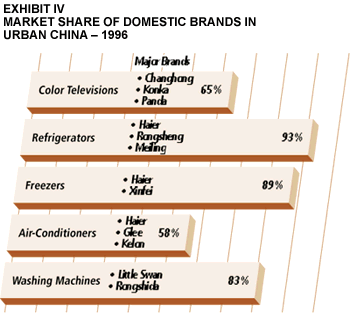
Local players naturally have felt the pressure from multinationals and overseas Chinese companies. In some sectors, such as beverages, film, personal care and skin care, some consolidation has already occurred at the expense of the local enterprises. However, local players remain strong in other sectors. The television, refrigerator, freezer, air-conditioner and washing machine sectors, for instance, are still dominated by local players. (See Exhibit IV.)
In the household chemicals business, Jahwa, a Shanghai enterprise that split from a joint venture with S.C. Johnson a few years ago, has bought back its Maxam brand and has proven to be competitive in specific sectors. Olive Shampoo, from the Sichuan province, has come from nowhere to take the market leadership in the herbal shampoo segment. Jianlibao, a local maker of sports drinks, is a respectable competitor with even Coca-Cola and Pepsi because of its shrewd marketing. Tsingtao beer remains the most popular local brand. In the personal computer sector, local brands of Legend and Great Wall are among the largest market-share players.
The intensifying competitive environment is complicated by China's rapidly changing consumer markets and regulations. Multinational companies often bring their world-class practices to China, where local players are quick to adopt those practices to enhance their own competitiveness. The overseas Chinese bring cultural understanding and often international exposure to China as well. Some companies are learning how to operate effectively in China while others are still adapting. As a result, the competitive landscape is volatile; the market shares of many consumer products tend to change, sometimes drastically, within short periods of time.
MIXED PERFORMANCE
To date, the financial performance of multinational companies in China has been mixed. Some have found early success and are willing to invest more, but many others have been losing money.
As mentioned, Procter & Gamble is generally viewed as a best-practice company in China, where it sells in more than 500 cities. Nestlé has a dominant position in the coffee market. Both Coca-Cola and Pepsi have major shares in the carbonated drink market. McDonald's and Kentucky Fried Chicken have established their presence in many Chinese cities, and have set the trend for fast food there. China is already one of the largest, if not the largest, markets for Ericsson and Nokia. Volkswagen's joint venture in Shanghai has more than a 50 percent share of the passenger car market in the whole country.
Yet for every multinational enjoying success in China, there are probably many others that have found China to be frustrating. It would be wrong, however, to imply that it is impossible for consumer product companies to make money in China, as some industry observers assert. To that end, tracing the root cause of a company's financial performance is necessary.
In some cases, the financial loss can be attributed primarily to inappropriate investment decisions, including those related to transferring expatriates to China and overhiring local staff for training. In other cases, however, the problem can be traced to misjudgment and mismanagement of the business. While the common pitfalls encountered by multinationals in China will be highlighted next in this article, the overall challenge that they face is to develop a good grasp of the revenue side of their businesses (i.e., understanding the competition, market, consumers and pricing), and to carefully manage the cost side, with a clear understanding and separation of operating expenses and investments.
Most multinational companies have reached a fork in the road. They must review their current approach and competitive position in China to develop appropriate new strategies and capabilities. In short, they have to decide if they want to continue to invest in China to strengthen their business and take it to the next level of performance.
While a few have decided to divest from China, such as Whirlpool from its refrigerator and air-conditioner ventures and Peugeot from its Guangzhou sedan operation, most see the market's potential as being so substantial and the global competitive implications of operating there as being so critical that they are continuing to invest.
Therefore, the search for an approach to achieve profitable growth in the Chinese consumer market is a key part of the agenda for the chief executives and China-based general managers of many multinational companies.
COMMON PITFALLS
Given the complexity of operating in the China market because of its vast size, regional diversity, poor infrastructure and shortage of skills, many multinational companies have found themselves making fundamental mistakes in managing their businesses. Highlighting the common pitfalls provides some useful insights.
Lack of Real Understanding of the Chinese Consumer. Our experience indicates that multinationals initially held a simplistic view of Chinese consumers. All too often, companies -- especially during the early stage of their arrival in China in the 1980's -- made statements like this one: "There are 1.2 billion Chinese, and if each person buys x number of products per year, then our market in China will be this large..." "Just sell" was the motto for many consumer product companies in China for some time.
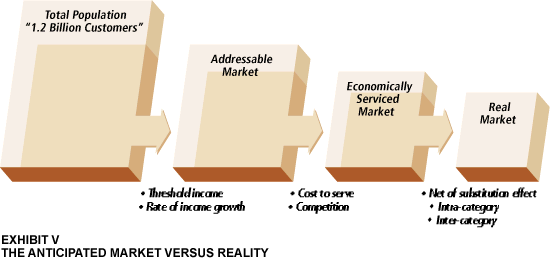
However, the needs and characteristics of various market segments are very different. Great diversity exists between major urban centers like Beijing, Shanghai and Guangzhou, and between large cities, small cities and rural areas within the same geographic region. For example, the official household income of the top three urban centers is seven times greater than that of surrounding rural areas. In addition, the cost to serve and the nature of competition often vary by market segment. As a result, the real market size can be very different from that originally anticipated. (See Exhibit V.) Some companies have retrenched from this broad-brush approach, focusing instead on a few high-priority markets.
Many of these initial segmentation approaches were rudimentary, however, and also did not necessarily reflect the real situation in China. Some companies used income as a parameter for segmentation, which intuitively should be the right thing to do. However, reported income often neglects much of China's underground economy, which is substantial in big cities.
Although the situation is changing, the disposable income of Chinese consumers, as a percentage of their total income, is often significantly higher than those of consumers in more developed countries. This is because the basic benefits of employees in the state sector -- which still constitutes the largest portion of Chinese employment -- are paid for by the state, notably housing, health care and education. Similarly, a high percentage of consumer products, especially fast-moving consumer goods, is made by state enterprises, which often buy these products and distribute them to their employees as part of the benefits package. In an emerging market like China, both intra- and inter-category substitution are rampant as various consumer product categories compete for "the share of the wallet" of the consumer.
Too often, companies focus on understanding only the current demand of the consumer. A better course is to anticipate or even create demand. Through smart marketing, Procter & Gamble, for example, created the perception that dandruff -- traditionally a non-issue for the Chinese -- is a social stigma and offered a product (Head & Shoulders anti-dandruff shampoo) to "solve" the problem. Today, Procter & Gamble controls more than half of the shampoo market in urban China. Along the same lines, Ting Hsin, the Taiwanese company, anticipated the Chinese need for more convenient and hygienic fast food, and was the first to offer instant noodles packaged in a bowl. This format became very popular and enabled Ting Hsin to capture more than 30 percent of the instant noodle market.
A more common pitfall, however, is the lack of understanding of the real drivers of demand for the different segments of Chinese consumers and how those drivers may change. For instance, a household cleaning products company found that sales in major cities were substantially lower than initial predictions, using a "threshold income" approach. This analysis suggested that a significant segment of households had already crossed the threshold. However, further investigations revealed that generally poor living conditions -- especially in Shanghai, where shared kitchen and bathroom facilities were common -- created a disincentive to purchase cleaning products, irrespective of income levels. Instead, people preferred to spend their disposable income on products and services that provide instant value, such as television sets, white goods or a family dinner at McDonald's.
In an emerging market like China, policy, regulations, income and consumption patterns can change rapidly. Companies that can anticipate these discontinuities can turn them to their advantage. In the household cleaning product example, a recent decision by the Chinese Government to develop a nationwide affordable housing program, supplemented by a new mortgage program, may lead to tens of millions of households moving into new dwellings over the next several years. Focus groups with Chinese consumers suggested that people would be willing to spend money to keep their homes in good condition; hence, there could be a surge in demand for "modern" household cleaning products.
The challenge for companies is to anticipate the magnitude and timing of new demand by product and by geographic location.
Ineffective Sales and Distribution. The Chinese distribution system has undergone major changes since the economic reforms of the last decade. In the past, products were handled in a rigid, tiered, category-specific system in which the distributors were responsible only for physical distribution. They were not responsible for any commercial value-added. Direct sales by manufacturers were almost nonexistent.
As the economic reforms began to emerge, the distribution system began to disintegrate and the tiers and category-specific constraints were broken. Some manufacturers, especially multinational companies, chose to go direct. However, the structural change did not bring a consequent change in the typical distributor's skills, at least to a level that is required for effective distribution in the new business environment. While the overall distribution skills are improving, they often cannot keep up with quickly evolving business requirements. This mismatch has caused many problems for the multinational companies' distribution in China.
The situation is complicated by the fragmented nature of the retail structure in Chinese cities. In a typical city, there are dozens of major department stores, hundreds of supermarkets, thousands of "grocery stores" and tens of thousands of small "mom-and-pop" stores and kiosks.
As a result, many multinational companies have problems managing their sales and distribution. Often they find that the coverage and penetration of their products is ineffective. At the points of sale, basic "blocking and tackling," such as merchandising and shelf management, are often not handled appropriately, if at all. Collection is often a problem. And logistics is often a major headache.
The root causes are plenty. Many multinationals did not develop an understanding of the distribution and retail structure in each of the markets in which they operate. Many have not understood the relative share of sales per type of account, the cost to serve and the service requirements by account type. Often, there was not a clear evaluation of when direct sales would make better sense than using distributors, and vice versa.
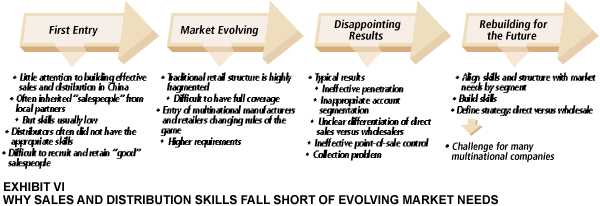
In addition, many multinationals face the challenge of building a skilled sales force in China. Some of them inherited "salespeople" from their joint venture partners; however, many of these people turned out to be from the old generation and were not equipped with the skills required to be effective in a market economy. Recruiting in China can be difficult because of today's low skill base. In short, many multinationals find that their sales and distribution skills are not commensurate with the evolving market needs. (See Exhibit VI.)
Still, examples of good sales and distribution practices do exist. Procter & Gamble gives bonuses to selected distributors' employees, who in turn help the distributors focus on facilitating the distribution of the company's products. Coca-Cola sells soft drinks using a direct sales force for each area within 50 kilometers of a bottling plant. Unilever's Walls ice cream dominates the Beijing market through the use of the company's exclusive distributors, backed up by Unilever's own salespeople. Avon's door-to-door direct sales have enjoyed overwhelming success as armies of saleswomen descend upon urban and rural households.
Operational Inefficiencies. Today, many multinational companies tend to focus on marketing and distribution. However, in doing so, they often neglect the important operational aspects of their businesses. When many companies first entered China, they thought local costs were low and did not pay attention to managing efficient operations. But the actual costs of operating in China can be high. Though they have leveled off recently, local costs, for both labor and management, have increased substantially over the last several years. Because of the need for allowances, expatriate costs in China are often higher than projected.
Manufacturing and sourcing costs can also be high. Comparatively low labor productivity, inadequate inventory management skills and systems, and suboptimal quality control (often leading to re-work) are common contributors to the high cost of operations. Although the situation is improving, many manufacturing companies in China still need to source much of their supplies through imports.
As a result, many multinationals find that while they are selling in an emerging market, their costs can be "first world." In one fast-moving consumer goods joint venture, the unit manufacturing cost in China was, at best, at parity with other plants around the world. For some products, it was more than 30 percent higher.
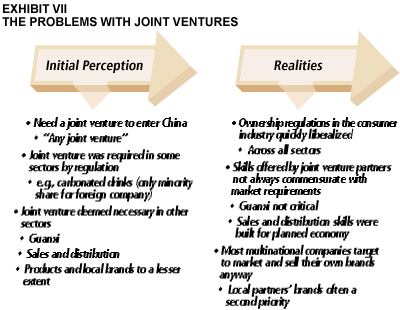
Inappropriate Ownership Approach. Many multinationals entered China thinking that they needed a joint venture partner, or arrived during the time when they were required by the Chinese Government to have such a partner. Often the motto was "Just get me into China with a joint venture -- any joint venture." In many cases, the companies were convinced that guanxi, or connections, was essential for success and that a local partner could bring the right guanxi to their business. However, after years of experimentation, many "joint venture" relationships became problematic. (See Exhibit VII.)
Many multinationals found that the value added from the local partners did not meet their expectations or requirements. The old notion of guanxi turned out to be irrelevant for some consumer products and services. For example, companies need to build new business relationships by identifying and developing the right distributors, managing rapidly evolving retail formats and cultivating relationships with the Chinese media. Often, the multinationals sought local partners to offer sales and distribution presence and skills. But in most cases, the skills of the local partners fell short because they were geared to the old planned economy.
Another common complaint was over the local partner's inability to increase investment in the joint venture. An increase is often sought after the relationship is well established and the foreign partner wants to expand operations. In many cases, though, the local partner is not willing to contribute, claiming that it does not have the money, the proposed expansion goes beyond its own geographic or product boundary or it needs to channel its funds back to its supervising organization.
Yet another typical reason for disappointment is a disagreement between the foreign and local partners over strategic and operational issues. Brand focus and product focus are two of the most common areas of contention. The foreign partner naturally wants to push for its own brand in China while the local partner often wants to do the same with its own local brands. Often the positioning, perceived image and targeted consumer segment of the brands are different.
Thus, the experience of many Sino-foreign joint ventures has not been very positive. As noted, S.C. Johnson and Jahwa terminated their joint venture, with Jahwa buying back its local brands. Pepsi and Coca-Cola had to restructure their joint ventures from minority equity shares to majority control. And Procter & Gamble had to restructure its first joint venture, which made soap and skin-care products in Guangzhou. All of these multinationals are now pursuing alternative ownership structures.
CONCLUSION
China has a diverse, complex and rapidly changing economy. The advancing consumers, changing demographic structures, intensifying local and international competition and consequent mixed financial performance of multinational companies make China's market one of the greatest management challenges for the decades ahead.
Avoiding common pitfalls provides some direction for improving future performance. Understanding consumer segments, identifying the real drivers of demand, fostering better sales and distribution skills, establishing effective operational performance measures and choosing the appropriate ownership structure are all key to building a greater China business.
Multinational companies will no longer be able to wing it in China; rather, they will need to take a rigorous integrated approach. For those that compete well, the experience and knowledge -- on top of the financial gains -- that they gather in China will be very rewarding, not only for their China operations but also for their businesses around the world. ![]()
Reprint No. 98202


